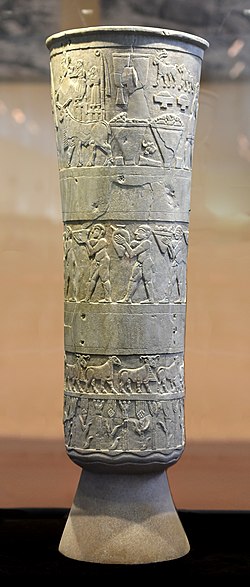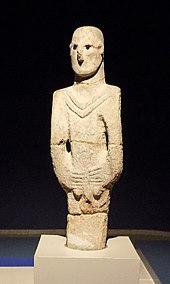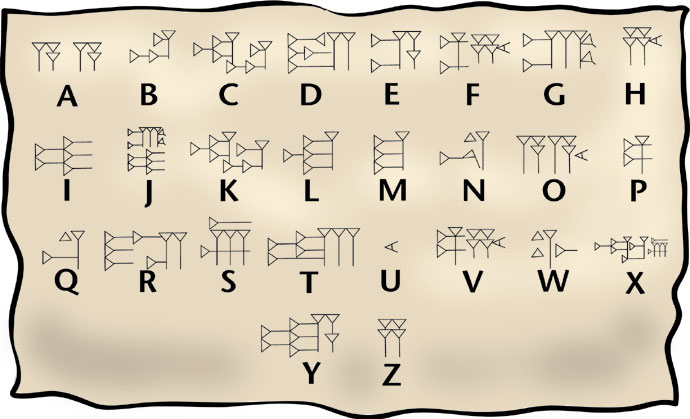Mesopotamia civilisation
Arts

Historians have labeled the two sides of the Standard 'War' and 'Peace,' and for those who believe the Standard depicts an historical account of an actual event, the 'War' side is the chronological beginning. The top row on this side depicts the end of the battle. The king of Ur (who is noticeably larger than the rest of the figures) accepts the enemy's surrender, while also taking many prisoners of war. The second row depicts the Sumerian soldiers, in full battle armor, at first on the march and then slaying their enemies on the field of battle. The bottom row has proven to be one of the more contentious rows of the Standard. While some historians believe it to be a depiction of the Sumerian chariot attack, others think it is the post-battle procession (with the king's chariot in front) leading the army back to Ur .
Warka vase

The worship of Inanna by the king of Uruk dominates the decoration of the vase. The top illustrates how the cultic duties of the Mesopotamian king as chief priest of the goddess, put him in a position to be responsible for and proprietor of, the agricultural wealth of the city state.
Pre -pottery

Around 8000 BC, during the following period of Pre - pottery neolithic B, still before the invention of pottery, several early settlements became experts in crafting beautiful and highly sophisticated containers from stone, using materials such as alabaster or Granite , and employing sand to shape and polish. Artisans used the veins in the material to maximum visual effect. Such object have been found in abundance on the upper Euphrates river, in what is today eastern Syria, especially at the site of Boquers .
In northeastern Mesopotamia, the jarmo culture (7500 BC), centred on the site of jarmo (Qal'at Jarmo) is a prehistoric Ar located in modern Iraq on the foothills of the Zagros mountains. Excavations revealed that Jarmo was an agricultural community, dating back to 7500 BC, based on irrigation through natural rainfall. It preceded the human expansion towards the alluvial plains of central Mesopotamia. It was broadly contemporary with such other important Neolithic sites such as Jericho in the southern Levant ,Catal huyuk in Anatolia or Tell sabi abyad in northern Syria . Some fragments of stone vessels and alabaster jars have also been found in Jarmo, dating to circa 7500 BC, before the c.7000 BC invention of pottery
Mask of warka

This is the first almost complete and life-size depiction of the human face in history, with respect to its anatomical details. It is made of marble and is about 20 cm tall. The eyes may have been inlaid with shells and lapis lazuli. The head might have been part of a large cult statue or it was attached to a Wall. It may represent the Sumerian goddess Inanna (Akkadian Ishtar ). It was excavated by a German archaeological team in 1939 CE, in a Temple dedicated to Inanna at the Sumerian City of Uruk (modern-day Warka), southern Iraq, and has been in the Iraq Museum since then. Shortly before the US-led invasion of Iraq in March 2003 CE, the mask of Warka was removed from its display case and was stored in Room 104 of the Museum for safekeeping. Somewhere between April 10 to 12, 2003 CE, it was looted from the Museum after the fall of Saddam's regime. In September 2003 CE, a tip from an informant to the US Military police was received, which said that it was in a farm north of Baghdad. A raid was conducted by the US army and found the Mask of Warka after digging 15 cm in the dirt. It is now on display in the Iraq Museum in Baghdad, Sumerian Gallery. It dates back to Jemdet Nasr period, 3000-2900 BCE.
Life
Most people lived in mud brick homes. They were rectangular in shape and had two to three levels. The roofs were flat and people would often sleep on the roofs during the hot summers. The mud brick worked as a good insulator and helped to keep the homes a bit cooler in the summer and warmer in the winter.

Food style
The Mesopotamians also enjoyed a diet of fruits and vegetables (apples, cherries, figs, melons, apricots, pears, plums, and dates as well as lettuce, cucumbers, carrots, beans, peas, beets, cabbage, and turnips) as well as fish from the streams and rivers, and livestock from their pens (mostly goats, pigs, and sheep.

System of writing
Full writing-systems appear to have been invented independently at least four times in human history: first in Mesopotamia (present-day Iraq) where cuneiform was used between 3400 and 3300 BC, and shortly afterwards in Egypt at around 3200 BC.
Clay tablets

Clay Tablets Writing was inscribed on clay tablets. Scribes would take a stylus (a stick made from a reed) and press the lines and symbols into soft, moist clay. Once they were done, they would let the clay harden and they had a permanent record.
Comments
Post a Comment